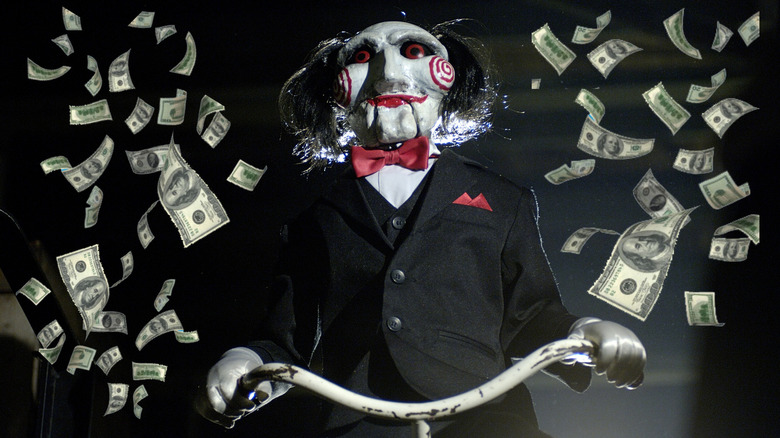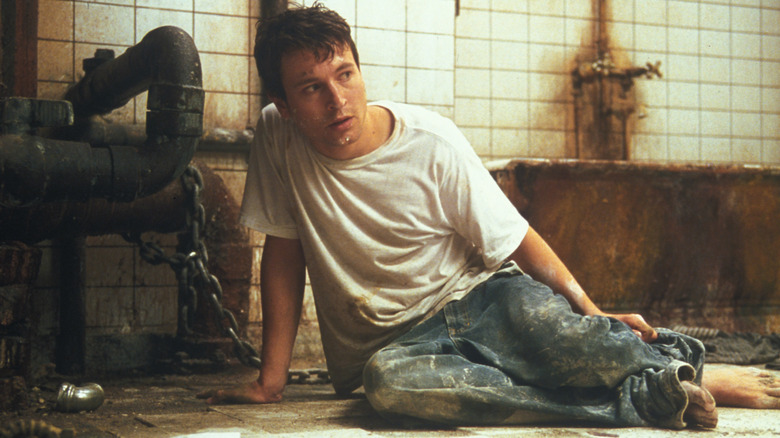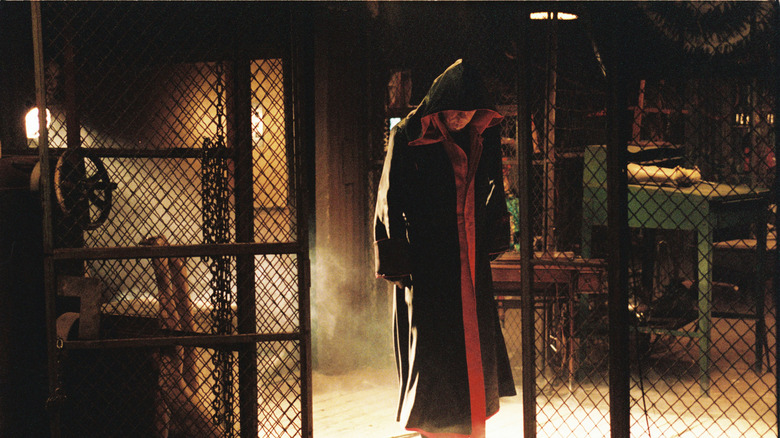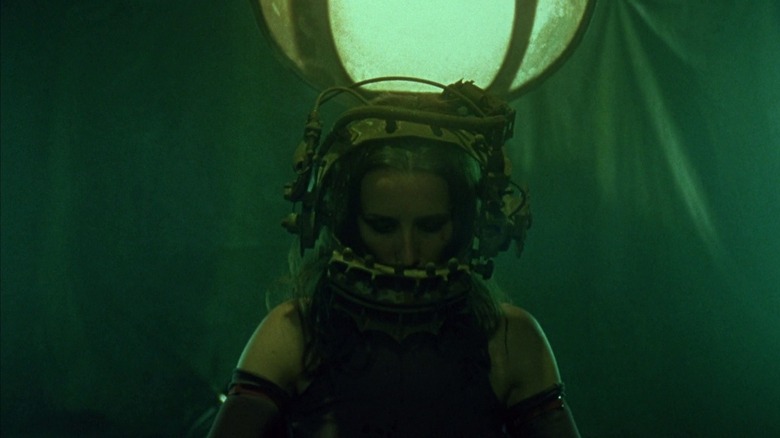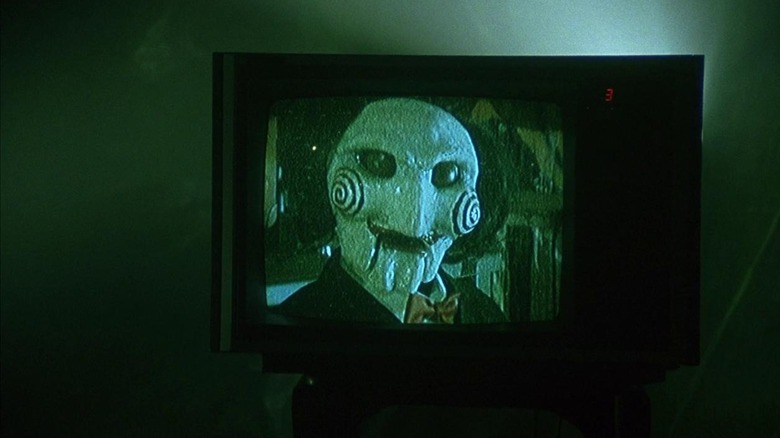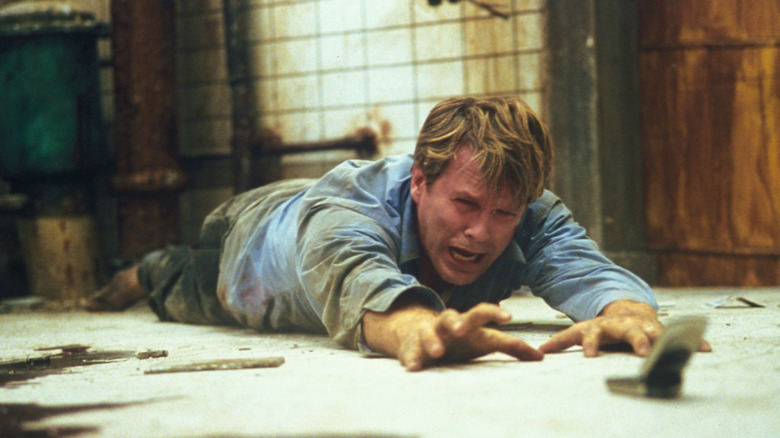Saw: The Gory Box Office Smash That Birthed One Of Horror's Biggest Franchises
(Welcome to Tales from the Box Office, our column that examines box office miracles, disasters, and everything in between, as well as what we can learn from them.)
James Wan is just about as successful as one can be as far as directing movies for the masses goes. We're talking about the man who started The Conjuring Universe, as well as the blockbuster "Insidious" franchise. Even outside of horror, he's helmed "Furious 7" and "Aquaman," two of the highest-grossing movies of all time. The man has an almost impeccable track record. Every master starts somewhere, and for Wan, it started in 2004 with "Saw." The difference is that Wan, right out the gate, launched an enduring $1 billion franchise with next to no resources to speak of.
Wan, like any filmmaker, was trying to find a way to break into filmmaking after college. He and his frequent collaborator Leigh Whannell, of "The Invisible Man" and "Upgrade" fame, decided they were going to try and make a movie on their own. The only problem? Movies cost money. "We wanted to make a movie, then we checked our bank balances, and we realized this was going to be the first 40-dollar movie in history. We had no money, to speak of," said Leigh Whannell, who co-wrote and starred in "Saw," to IGN in 2004. Luckily, the two came up with an idea too good to be ignored, and the movie got made. And not only did it get made, but it birthed one of the biggest horror franchises in the history of cinema.
In this week's Tales from the Box Office, in honor of the release of "Saw X," we're looking back at the original "Saw," the unique way that Wan and Whannell managed to sell their pitch, why they ended up taking a deal from a much smaller production company, what happened when the movie hit theaters, and what lessons we can learn from it nearly 20 years later. Let's dig in, shall we?
The movie: Saw
Wan and Whannell had no credits to speak of before "Saw," and they knew if they wanted to make a movie — be it self-funded or through more traditional means — it would have to be cheap. "It truly did come out of us wanting to make a really cheap film. After years of trying to get a film off the ground, we realized no one was giving us any money to make a film with. So we decided to sit down, write our own script, and see if we could fund it ourselves," Wan said in that same IGN piece.
"What's the cheapest thing we can do? Two guys in one room with no windows. We'll chain them up so they can't go anywhere. We'll keep them in this room. That's cheap. That's all we've got the money for," Whannell added. The duo not only wrote the script, but they also made a short for $2,000. They took one of the story's most harrowing moments and shot the entire scene. The scene in question is the now-infamous reverse bear trap.
The duo intended to make the movie dirt cheap on their own. However, their manager at the time convinced them after seeing the script that they should actually try and raise money to make the movie. So, they transferred the footage to DVDs and distributed them to financiers along with the script. The DVDs proved key, as moneymen could actually see what they had in mind.
Evolution Entertainment offered them the freedom they wanted — albeit with very little money to get the job done. But for Wan and Whannell, those were the perfect terms. "We actually got much better offers from other companies around town," Wan explained to The A.V. Club in 2010." I feel we got better offers from DreamWorks and Gold Circle at one point, and all these guys wanted it, right? But I think people weren't willing to take the chance on Leigh and myself."
Casting Jigsaw
In fairness, it is difficult to imagine a major Hollywood studio handing over a sizable budget to a pair of first-time filmmakers. But Evolution, whose Twisted Pictures division ended up handling the project, was willing to allow Wan to direct and Whannell to be one of the film's main stars. The catch? They were going to have to make the movie for $1.2 million. That's next to nothing for a theatrically released film. Luckily, Wan and Whannell planned it as a low-budget affair in the first place.
"Saw" opens with two strangers chained up in a room with no recollection of how they got there. Adam (Whannell) and oncologist Lawrence Gordon (Cary Elwes) try to put the pieces together in a filthy bathroom with a bloody, seemingly dead man in the center of the room. They're forced to play the Jigsaw Killer's latest game before it's too late. The only way out? Cutting off your foot with a cheap hacksaw.
Despite the low budget, Wan was able to cast some A-class actors such as Elwes, as well as "Lethal Weapon" star Danny Glover as Detective Tapp, who is obsessed with trying to bring Jigsaw down. As for the Jigsaw Killer himself, aka John Kramer? It was character actor Tobin Bell who ultimately landed the role and, in his 60s, ended up completely redefining his entire career with a single role. Speaking in 2017, Bell explained his decision to take on the role, and a lot of it had to do with Glover:
"I had never worked with Danny Glover, and I wanted to work with him. I thought that three guys locked in a room was, like ... no one was making films about three guys locked in a room [...] Then, the ending, which I did not anticipate when I read the script. I thought, if they shoot this well, it could be one of those really shocking moments in film, that, if you do one of those, in an entire career, it's great."
The financial journey
Not to spoil it, but Bell would have not just one of those movies in his career, but ten of them as of this weekend, as his role as John Kramer has become an essential part of the horror canon, right up there with Jason Voorhees and Freddy Krueger. Indeed, "Saw" kind of became the little movie that could — and rapidly at that. Just six months after arriving in Los Angeles, Whannell and Wan had finished shooting the film. With Lionsgate, a young and hungry studio looking for an identity at the time, on board to distribute, things were looking up.
R-rated, gory, and complete with a marketing campaign that was happy to lean into the shock value, "Saw" hit theaters in time for Halloween on October 29, 2004. It was competing against "The Grudge" in its second weekend, as well as "Ray," which would end up winning Jamie Foxx an Oscar. It was a relatively stacked weekend, but that wasn't a problem. Wan's directorial debut opened to a strong $18.2 million, placing number three on the charts domestically. Against its tiny budget, that made it an immediate success.
Luckily though, word of mouth caught on as the movie garnered that "you need to see it to believe it" hype that can't be bought. As a result, the film held strong in the coming weeks, even as big movies like "The Incredibles" and "National Treasure" opened. "Saw" finished its run with $55.2 million domestically to go with a very solid $47.9 million internationally for a grand total of $103 million globally. That equates to more than 85 times its production budget. Naturally, Lionsgate was very quick to green-light a sequel. With that, a new Halloween tradition was born.
Saw becomes an annual sensation
Even though Wan didn't return to direct, "Saw II" opened exactly one year later in 2005 and was an even bigger hit, taking in $152.9 million. And so it went, as five more sequels followed annually through 2010's "Saw 3D," all of which were big hits. Even 2009's "Saw VI" earned $69.7 million against an $11 million budget, a return on investment that any studio in Hollywood would happily take to this day. Lionsgate always kept the budgets reasonable and delivered horror lovers a new chapter every single year until they felt the series had run out of juice. The genre hadn't really had something like this since the '80s when the "Friday the 13th" movies were a yearly occurrence. It's rare air.
Tobin Bell's Jigsaw became a horror icon and, despite dying in "Saw III," he has starred in every entry, including, rather improbably, "Saw X," which is actually a prequel that takes place between the events of the first two entries. The fact that Lionsgate wanted to do that this late in the game speaks volumes about Bell's place in the genre movie canon. Wan, in his first feature, delivered a character that will outlive us all. No small feat. To date, the films have collectively earned $1.02 billion worldwide and counting.
The films ended up being dubbed torture porn by the masses, even if Wan and Whannell disagree with that classification. Regardless, the films are unabashedly gory and, at that time, it wasn't all that common for such gory pictures to enter the mainstream in such a meaningful way. It arguably paved the way for a string of other gory hits as well, including Eli Roth's "Hostel," "The Hills Have Eyes" remake, and numerous others. "Saw" not only started a massive franchise, it gave way to a full-on mainstream gore trend as well. Not bad for a movie that was made by a couple of nobodies who sold the idea using a DVD.
The lessons contained within
There are numerous movies that have humble beginnings and go on to become hits, but it's hard to find a movie more humble than "Saw" that generated so much in the wake of its unexpected success. There just aren't that many $1 billion franchises out there period, let alone ones that started with a $1 million movie from untested filmmakers. It's truly one of the most incredible success stories of the last 25 years in cinema.
What stands out is just how adamant James Wan and Leigh Whannell were in terms of betting on themselves. They were determined to make a movie and wrote something that could conceivably be filmed on a shoestring budget. They knew they had a vision, and spent what little money they had to demonstrate that vision to the gatekeepers in Hollywood. They could have made more money when, by their own admission, they had no money to speak of. Yet, they took a smaller deal so that they could bring their vision to life, their way. That decision absolutely panned out, but for hungry filmmakers trying to make a name for themselves, turning down the upfront money is a big decision.
Maybe even bigger than that, Wan and Whannell continued to bet on themselves in the aftermath. They also collaborated on the micro-budget "Insidious," which was another gigantic hit that spawned a franchise. Quite frankly, Wan is one of the only filmmakers out there producing original hits with regularity, even if those hits often turn into franchises. Just look at what "M3GAN" did earlier this year.
The landscape of cinema might literally look different today if these two had a) taken a deal from a different studio and b) stuck around to make a bunch of "Saw" sequels. Wan directed the highest-grossing DC movie of all time. Whannell made the best Universal Monsters movie in ages with "The Invisible Man." None of that happens without "Saw." Modern cinema is all the better thanks to their integrity and determination.
